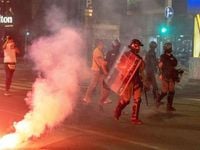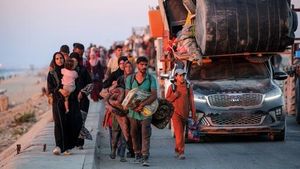Serbia found itself at the center of a tense political standoff this past weekend, as both anti-government protesters and supporters of President Aleksandar Vucic staged parallel rallies across the country. The events, unfolding on Saturday, September 13, 2025, marked more than ten months of sustained unrest in the Balkan nation, revealing deep divisions over the future direction of Serbian politics and society.
The origins of this crisis trace back to a tragic incident in November 2024, when a concrete canopy at a renovated train station in Novi Sad collapsed, killing 16 people. According to Al Jazeera and the Associated Press, this disaster ignited a student-led protest movement that initially focused on seeking justice for the victims and demanding a thorough investigation into corruption allegedly linked to the tragedy. Over time, the movement’s demands broadened, eventually calling for President Vucic’s resignation and sweeping changes to the country’s governance.
President Vucic, whose Serbian Progressive Party has dominated the political landscape for years, has responded to the persistent demonstrations by organizing his own counter-rallies. The aim, as reported by AP and Al Jazeera, is to showcase his base of support and push back against what he describes as attempts to destabilize Serbia. No major incidents were reported during Saturday’s rallies, which occurred in cities and towns throughout Serbia. Police maintained a visible presence, carefully separating the two camps to prevent violent confrontations. However, brief scuffles did erupt in the capital, Belgrade, when riot police pushed away anti-government demonstrators as Vucic made a public appearance among his supporters.
The president’s rhetoric has grown increasingly combative in recent weeks. He has refused to meet a key student demand to call early parliamentary elections and has instead intensified a crackdown on the protest movement. In public statements, Vucic has accused the student-led protesters of being “terrorists” who are, in his words, “working against their country under orders from the West.” Notably, he has offered no concrete evidence for these claims. During Saturday’s rally, Vucic sought to reassure his followers, stating, “People want to live normally, they don’t want to be harassed and want to be free.”
For many Serbians, the government’s response to the protests has been a source of growing alarm. Over the past several months, the crackdown has intensified, with demonstrators and international observers alike accusing the authorities of excessive force and political repression. According to AP and Al Jazeera, more than 100 university professors have been dismissed from their posts—many of them replaced by individuals with close ties to the ruling party. Police have also faced accusations of brutality against peaceful demonstrators, a charge that has only fueled public anger and drawn condemnation from abroad.
Earlier in the week leading up to the rallies, thousands had gathered in Belgrade to voice their opposition to the government’s actions. Among those speaking out was Nikolina Sindjelic, a student who was arrested during protests in August. Addressing a crowd outside the headquarters of a special police unit, Sindjelic recounted her experience in detention, stating, “They beat us because they are afraid of us. They have hit us and they will hit us because they know it is all over [for them].” Her words, reported by Al Jazeera, resonated with many in the crowd and underscored the sense of determination among the protest movement’s ranks.
The international community has taken notice of the escalating tensions in Serbia. During a visit to Austria on September 8, European Commissioner for Enlargement Marta Kos addressed the situation directly. “We have a problem in Belgrade. The people have the right to protest. The severe violence on the streets of Serbia, the many acts of vandalism, must stop. We expect the police to act appropriately and respect fundamental rights,” Kos stated, as quoted by Al Jazeera. Her remarks reflect growing concern in European circles about the trajectory of Serbian democracy and the government’s willingness to respect basic civil liberties.
Despite these calls for restraint and dialogue, the standoff shows few signs of abating. Vucic’s refusal to call early elections—a key demand of the protesters—has only deepened the impasse. Meanwhile, the government’s decision to dismiss more than 100 university professors, replacing them with loyalists, has fueled accusations of political purges and further alienated the academic community.
Both sides have dug in, with anti-government demonstrators insisting on accountability for the Novi Sad tragedy and broader democratic reforms, while Vucic and his allies frame the protests as a threat to national stability and sovereignty. The president’s supporters, mobilized through party-organized rallies, echo his claims that the demonstrations are orchestrated by foreign interests seeking to undermine Serbia. Yet, as AP and Al Jazeera have reported, Vucic has not provided evidence to substantiate these allegations.
For many ordinary Serbians, the ongoing crisis has become a test of the country’s democratic institutions and social cohesion. The student-led movement, which began with a focus on justice for the victims of the Novi Sad disaster, has evolved into a broader campaign for government accountability and the protection of civil rights. The government’s heavy-handed response—including police crackdowns, mass dismissals in academia, and the use of incendiary rhetoric—has only heightened tensions and drawn Serbia into the international spotlight.
With both camps showing little willingness to compromise, and with outside observers urging calm and respect for fundamental freedoms, Serbia faces a pivotal moment. The path forward remains uncertain, but the events of the past weekend have made one thing clear: the country’s political future hangs in the balance, shaped by the interplay of protest, power, and the enduring demand for justice.
As Serbia’s political crisis deepens, the outcome will depend on whether its leaders and citizens can find a way to bridge their differences—or whether the standoff will harden into a lasting divide.




